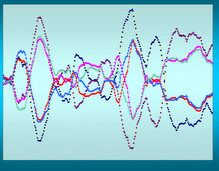Anyway. Eddy says: I like to track the CYC/S&P ratio, which often gives us a better reading on the economy’s health than any government report. The ratio increases when cyclicals outperform, and decreases when cyclicals underperform. Eddy has a couple of other things to say about this and it is probably worth the read.
So I pulled up a picture of the ratio done from the basis of Marlyn's Curve and guess what I see - we are reaching a turning place. Eddy sees that too - Cramer doesn't - so maybe they aren't the same guy or maybe this is just standard Cramer calling an up in one venue and a down in another. I don't know, I don't care - but if you look at the chart you will see volatility decreasing and that the turn point is very near.

This chart is on a weekly basis and shows the last 8 years or so of the ratio. That puts it back into boom time, through the last recession of 2001 - 2003 (boxed in on the chart) and into the current times.
Now here is Marlyn's curve - this chart shows how these two indices play together - but the one thing you can't help but notice is that the SPX turns first - both down and up. Very seldom do the "cyclicals" lead. The second thing I noticed was the same thing I noticed on the other chart and indicated with the arrows and lines - volatility is disappearing even in the cyclicals. This chart is the same basis as the last.

The last thing I want you to make note of - the SPX is rolling over. Now that doesn't mean that it has to go down very far and in fact it doesn't anymore but it is going to take a rest in the near future so be prepared for it when it comes.

1 comment:
Stocks always move in cycles.
Post a Comment